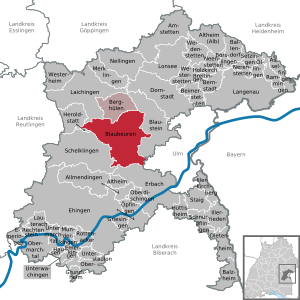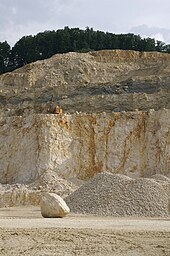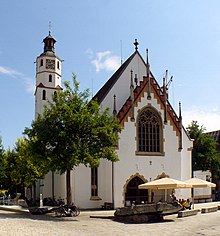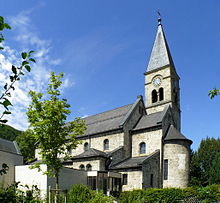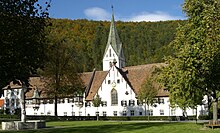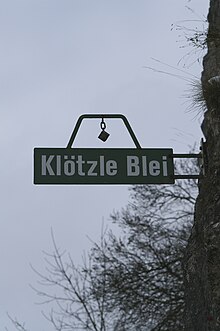Blaubeuren
| coat of arms | Germany map | |
|---|---|---|

|
Coordinates: 48 ° 25 ' N , 9 ° 47' E |
|
| Basic data | ||
| State : | Baden-Württemberg | |
| Administrative region : | Tübingen | |
| County : | Alb-Danube district | |
| Height : | 516 m above sea level NHN | |
| Area : | 79.15 km 2 | |
| Residents: | 12,521 (Dec. 31, 2018) | |
| Population density : | 158 inhabitants per km 2 | |
| Postal code : | 89143 | |
| Area code : | 07344 | |
| License plate : | UL | |
| Community key : | 08 4 25 020 | |
City administration address : |
Karlstrasse 2 89143 Blaubeuren |
|
| Website : | ||
| Mayor : | Jörg Seibold | |
| Location of the town of Blaubeuren in the Alb-Donau district | ||
Blaubeuren is a town in the Alb-Donau district in the east of Baden-Württemberg .
geography
Geographical location
The core town of Blaubeuren lies at the foot of the Swabian Alb , 16 kilometers west of Ulm . The current districts of Seißen with Wennenden and the Steigziegelhütte as well as Sonderbuch, Asch and the Hessenhöfe, which were incorporated during the regional reform in 1975 , are located north on the plateau of the Swabian Alb , the villages Beiningen, Erstetten and Pappelau south on the Hochstrasse . Gerhausen and the main town of Blaubeuren are located in the Blautal . Like Gerhausen, the Weiler district in the Aachtal has largely grown together with the main town of Blaubeuren.
Neighboring communities
The city borders in the north on the district of Suppingen of the city of Laichingen and Berghülen , in the east on Blaustein , in the south on Ulm and Erbach and in the west on the city of Schelklingen and the municipality of Heroldstatt .
City structure
The town of Blaubeuren consists of the districts of Blaubeuren, Gerhausen , Altental , Asch , Beiningen , Pappelau , Erstetten , Sotzenhausen , Seißen , Wennenden , Sonderbuch and Weiler with the core town of Blaubeuren and 18 other villages, hamlets, farms and (individual) houses.
history
prehistory
In the Blau- and Aachtal in the vicinity of Blaubeuren there are several caves with important archaeological sites of ice age hunters and gatherers ( Upper Palaeolithic ). The Glass Cave , the Hohle Fels (near Schelklingen ) and the Geißenklösterle are mentioned . Finds and excavation results are presented today in the Prehistory Museum .
middle Ages
There was already a settlement in Beuren an der Blau in the Alemannic settlement period (6th / 7th centuries), and graves from this time were found on the Rucken. A chapel dedicated to John the Baptist also existed here early on. The nucleus of today's city, however, is the Benedictine monastery Blaubeuren , founded around 1085 by the Counts of Tübingen am Blautopf , which monks from Hirsau monastery moved into. The monastery encouraged the influx of craftsmen and servants and had market rights , so that a secular community quickly developed around the monastery, which when it was first mentioned in two documents issued on December 24, 1267, was already in the possession of the Count Palatine of Tübingen as a fortified town appears.
In 1282 the city was inherited by the counts of Helfenstein through the marriage of a daughter (Agnes) of Count Rudolf I the Scheerer of Tübingen-Herrenberg with Count Ulrich II. Von Helfenstein . His son Ulrich III. sold the city on August 28, 1303 to the Dukes of Austria, but received it back immediately as an inheritance. The local rule remained with the Counts of Helfenstein until they sold it (after several pledges from 1384) to the Counts of Württemberg in 1447.
Württemberg time
A city school is documented as early as the 14th century, in 1418 the market rights were extended by King Sigismund and then a town hall (department store) was built on the market, around 1425 a hospital was founded. In the Württemberg period after 1447, the city became the seat of the Blaubeuren office and thus received an important administrative function for the surrounding towns. Württemberg also reformed the municipal administration, so that in the middle of the 15th century a council made up of citizens appeared for the first time in addition to the mayor.
The Reformation was carried out in 1534/1535 without much difficulty. As a result, the monastery was abolished and converted into a Protestant monastery school, which continues in the Protestant seminary, an old-language grammar school, which has existed since 1817. The income from the clergy fell to the Duke of Württemberg, and the hospital was transferred to the city in 1537. Around 1540 the city gained a monopoly on the iron and salt trade, and in 1608 the market rights were extended to include two more markets.
In the course of the Thirty Years' War Blaubeuren briefly fell back to Austria, and the monastery was once again inhabited by monks. After 1635 the place was the scene of fighting and was partly devastated. After 1637 the Austrian rule tried to restore the Catholic faith against the will of the population. After the Peace of Westphalia in 1648, Blaubeuren was returned to the Duchy of Württemberg .

Until the end of the Holy Roman Empire (1806), Blaubeuren was the border town of the duchy and at the same time the official town (later Oberamt). The Oberamt Blaubeuren (comparable to a district) existed during the time of the Kingdom and People's State of Württemberg until 1934 and was then continued under the name of Blaubeuren district . In 1938 this was dissolved in the course of an administrative reform during the Nazi era ; Most of its communities, like Blaubeuren themselves, were added to the Ulm district.
Until the beginning of the 19th century, Blaubeuren did not grow beyond the medieval city wall. That only changed in 1830, when it was partially demolished in the course of industrialization . The focus was on the exploitation of the lime deposits in the Blautal and the associated settlement of the cement industry in the middle of the 19th century. The city expanded further, this time to the south, after 1868, when the Royal Württemberg State Railways were connected to the Ulm – Sigmaringen railway with the opening of the Blaubeuren station .
Cement factory
Under the leadership of the "Blaubeuren Gebrüder Spohn Cement Factory" founded by Julius Spohn in 1875 , the southern German cement factories merged to form a cartel in 1903 . In the following year, the Blaubeurer cement works was converted into a stock corporation , Portland-Zement Blaubeuren Gebrüder Spohn AG . In 1938 the majority of this was taken over by Portland-Zementwerke Heidelberg AG (later HeidelbergCement AG ). It was fully integrated into the Heidelberg cement group in 1966. With the demolition of the unprofitable cement plant in 1998/1999 by HeidelbergCement AG , the history of Blaubeuren as an important location for the European cement industry ended.
post war period
In 1945, as part of the Ulm district, Blaubeuren came into the American zone of occupation and thus belonged to the newly founded state of Württemberg-Baden , which was incorporated into the current state of Baden-Württemberg in 1952. In 1973 the district reform took place in Baden-Württemberg , when Blaubeuren became part of the Alb-Donau district.
In the course of the municipal reform in Baden-Württemberg , the previously independent municipalities Asch and Sonderbuch were incorporated on January 1, 1974, and the municipalities of Beiningen, Pappelau, Seißen and Weiler on January 1, 1975.
politics
Municipal council
In Blaubeuren, the municipal council is elected using the spurious selection of a part of town. The number of local councils can change due to overhang mandates . The municipal council in Blaubeuren has 25 members after the last election (unchanged). The local elections on May 26, 2019 led to the following preliminary final result. The municipal council consists of the elected voluntary councilors and the mayor as chairman. The mayor is entitled to vote in the municipal council.
In the case of the Unechte Teilorteschahl, the municipality is divided into seven electoral districts, which are called residential districts according to the Baden-Württemberg municipal code , whereby in some cases several districts are combined into one residential district. In addition, six localities (Asch, Beiningen, Pappelau, Seißen, Sonderbuch and Weiler) have been set up within the meaning of the Baden-Württemberg municipal code, each with its own local council and mayor as its chairman. The local councils of the localities of Pappelau and Seißen are elected according to the system of sub-local selection and the two localities are also divided into residential districts for this purpose.
| Parties and constituencies |
% 2019 |
Seats 2019 |
% 2014 |
Seats 2014 |
||
| FW | Free voters | 34.8 | 9 | 39.5 | 10 | |
| CDU | Christian Democratic Union of Germany | 21.2 | 5 | 25.1 | 6th | |
| SPD | Social Democratic Party of Germany | 20.8 | 5 | 19.5 | 5 | |
| GREEN | Alliance 90 / The Greens | 23.2 | 6th | 15.9 | 4th | |
| total | 100.0 | 25th | 100.0 | 25th | ||
| voter turnout | 57.3% | 50.5% | ||||
badges and flags
Since 1471, the coat of arms has shown the so-called “Blaumännle” - a standing, blue-clad man on a golden background, with a green wreath in his hair, with each hand holding an upright black stag stick turned outwards .
The Blaubeurer city colors are blue-yellow.
mayor
Mayor of the city of Blaubeuren is Jörg Seibold. The first term of the diploma administrative host (FH) and graduate management scientist began on July 3, 2002. He sat on 21 April 2002. In the first ballot with 67.3% against three competitors through and thus, succeeding George Hiller at who held the office for 24 years and no longer ran for election. In 2010 Seibold was confirmed in office with 98.4% of the votes. In the mayoral election on April 15, 2018, Jörg Seibold was re-elected with 92.3% of the votes cast and thus received a clear vote for a third term.
Town twinning
Sister city since 1990 Tharandt in Saxony . Further partnerships exist with the Brecknockshire district in Powys / Wales ( Great Britain ) and the municipalities of Kryštofovo Údolí (Christophsgrund) and Novina (Neuland) in the Czech Republic .
Economy and Infrastructure
Companies
The Merckle group (pharmaceutical industry) is headquartered in Blaubeuren. Centrotherm's head office is also in Blaubeuren .
traffic
The Blaubeuren station is located on the Ulm – Sigmaringen railway line and is a regional express stop. In the hour clock that connects the two cities on the Danube. Neustadt (Black Forest) is reached every two hours via Donaueschingen . In addition, trains on the regional train line Ehingen (Danube) - Ulm - Memmingen add to the timetable. Next to the Blaubeuren train station there is a stop in the Gerhausen district . Blaubeuren belongs to the Donau-Iller-Nahverkehrsverbund (DING). Blaubeuren is on federal highway 28 between Reutlingen and Ulm . The federal road 492 to Ehingen also begins in the city . The city can be reached from Stuttgart or Munich via the A 8, which is about 12 km away as the crow flies .
The Blaubeuren airfield is located in the Sonderbuch district (special landing site).
The Alb-Neckar cycle path reaches Blaubeuren as a long-distance cycle path . It leads from Ulm to Heilbronn .
Religions
Blaubeuren is the seat of the Blaubeuren church district of the Evangelical Church in Württemberg . All districts of Blaubeurens are evangelical. There are Protestant parishes in Blaubeuren, Gerhausen, Weiler, Seißen, Sonderbuch, Asch and Pappelau. Erstetten and Beiningen belong to the church of Pappelau.
In Blaubeuren there is the Catholic parish "Mariä Visitation" with a branch church in Gerhausen. On July 2nd, the Feast of the Visitation of the Virgin Mary , Blaubeuren is the destination of a pilgrimage with a long tradition, which has been preserved over the centuries even after the introduction of the Reformation.
The New Apostolic Church also has a congregation here.
Other free churches are the Ecclesia Blaubeuren (House of Hope) and the AlbKirche in Asch, which are part of the BFP .
The Muslim community in Blaubeuren, mostly Turkish, emerged after the migration of workers from Turkey in the early 1960s . Along with Ehingen and Ulm , Blaubeuren was one of the first in the region with the mosque community founded in the early 1980s . Today there is a Muslim place of prayer both in Blaubeuren and in the Gerhausen district. After the establishment of new Muslim communities in the neighboring towns of Schelklingen and Erbach , most of the houses are only used for the purposes of the local Muslim population.
Educational institutions
- The Heinrich Fabri Institute is a research institute in the humanities and social sciences of the Eberhard Karls University of Tübingen .
- The Joachim-Hahn-Gymnasium Blaubeuren is a state high school with a natural science and linguistic focus (Spanish). Since it received a new building funded by the IZBB with a cafeteria, exercise room, technical room, room of silence and library, it has also offered open all-day care.
- The Evangelical Seminary Blaubeuren , a state high school with a Protestant boarding school , still uses the premises of the monastery today.
- The Karl-Spohn-Realschule is located in the Gerhausen district.
- The Blautopfschule in Blaubeuren consists of a primary and secondary school with a technical school , which also houses a special needs school . Further primary schools are located in the Blaubeurer districts of Asch, Gerhausen and Seißen.
- In the core town of Blaubeuren there is a music school and an adult education center.
- In 1947 the first, no longer existing, accommodation of the then newly founded Christian Youth Villages Association (CJD) was founded in Blaubeuren .
Sports facilities
Blaubeuren has an indoor pool and an outdoor pool (Christian Schmidbleicher outdoor pool).
Culture and sights
Blaubeuren is on the main route of the Upper Swabian Baroque Road and the southernmost stretch of the German Half-timbered Road .
Buildings
The former Blaubeuren monastery, founded in 1085, is located directly on the Blautopf . In the monastery church there is a high altar from 1493 from the Ulm school and late Gothic choir stalls of the same age by Jörg Syrlin the Younger .
Blaubeuren also has an old town with numerous half-timbered buildings .
On a rocky mountain is the "Ruckenkreuz" erected in 1926, an 8.40 meter high memorial cross made of reinforced concrete with a span of 2.80 meters, which commemorates the fallen of the First World War.
In the north of Gerhausen there is a monolith , the "war memorial", which commemorates the fallen of the Second World War.
In the urban area are the remains of the castles Ruck and Blauenstein , Hohengerhausen (district Gerhausen), Greifen- or Günzelburg and Burkartsweiler (both districts Seißen), Sirgenstein (district Weiler), and finally Gleißenburg (district Beiningen).
Museums

The Prehistory Museum , which is connected to the Institute for Prehistory of the University of Tübingen, shows Paleolithic finds from the caves in the Ach Valley. Scientific knowledge, experimental archeology and modern museum didactics can be found here under one roof. The oldest figurative works of art found in the caves around Blaubeuren, including the Venus vom Hohle Fels, are juxtaposed here with modern art from the 20th century. One of the highlights of the museum is the presentation of flutes made from bird bone and mammoth ivory, the oldest musical instruments found in the world.
The former bath house of the monks in the monastery grounds presents the historical bathing facilities in the basement and the local history museum with furniture and objects from Blaubeuren on the upper floors.
The Schubartstube literary memorial is located in the former administrative building on the monastery grounds .
Natural monuments

The most striking sight in Blaubeuren is the Blautopf , a karst spring from which the Blau rises. With a depth of 21 meters, the Blautopf is one of the deepest and largest springs in Germany, from which between 310 and 32,000 l / s flow.
The Klötzle lead is known on the one hand from the butcher's rock in the city and on the other hand from a lead cube that is attached to this mountain. The term is known from the tongue twister: 's leit a Kletzle Blei glei at Blaubeira - glei at Blaubeira leit a Kletzle Blei (see Eduard Mörike's Stuttgarter Hutzelmännchen , story of the beautiful Lau).
In the Aachtal near Weiler, the rock labyrinth, the rock plateau of the former Günzelburg and the Geißenklösterle are geological features.
The caves around Blaubeuren with the oldest Ice Age art have been declared a World Heritage Site by Unesco .
Regular events
Once a year, a sled race that is unique in the world takes place in Gerhausen . At this event, known as the patent race, teams of drivers and brakemen compete against each other with their historic sleds. According to the patent specification of the Imperial Patent Office from 1911, a patent is a steerable toboggan sledge with elastic runners, the front part of which is bent to the side while steering.
Others
On the Schillerstein west of the partial local Gerhausen operates SWR the station Blaubeuren (Schillerstein) , the lowest performing radio stations in Germany.
Personalities
sons and daughters of the town
- Heinrich Schmid, later Heinrich III. Fabri († 1493), abbot of the monastery; as an advisor and friend of Count Eberhard im Bart, co-founder of the Eberhard Karls University of Tübingen
- Johannes Lupfdich (around 1463–1518), law professor in Tübingen, lawyer and counselor in various services
- Laurentius Autenrieth (1483–1549), abbot of the Benedictine monastery in Lorch
- Berthold Schauer († before 1496), master goldsmith, active in Salzburg
- Johann Magenbuch (1487–1546), city physician in Nuremberg and personal physician
- Nathanael Köstlin (1744–1826), Protestant theologian and honorary prelate in Urach
- Christoph Gottfried Bardili (1761–1808), philosopher
- Johann Gottlob Veiel (1772–1855), Oberamtmann of Württemberg
- Carl Theodor Friedrich von Lang (1801 – after 1882), Oberamtmann in Württemberg
- Gottlob Adolf Veiel (1802–1864), lawyer and member of the state parliament
- Christian Friedrich Wurm (1803-1859), high school professor, historian, author and politician
- Matthäus Hipp (1813–1893), watchmaker and inventor
- Wilhelm Friedrich von Drescher (1820–1897), Oberamtmann of Württemberg
- Gustav Adolph Bockshammer (1824–1882), Oberamtmann in Württemberg
- Paul Wurm (1829–1911), Protestant pastor, theologian and publicist
- Karl Kübel (1852 – after 1929), architect
- Gerhard Günther (1889–1976), Protestant theologian
- Hans Gassebner (1902–1966), painter and graphic artist
- Wilhelm Schäfer (1902–1979), politician (NSDAP), district administrator in Crailsheim
- Otto-Günter Lonhard (* 1933), lawyer and local researcher
- Hansjörg Weitbrecht (1938–2019), industrial and business sociologist
- Wolfgang Schürle (* 1941), politician (CDU), district administrator of the Alb-Donau district
- Immo Eberl (* 1947), historian and university professor
- Volker Schneider (* 1952), political scientist, professor of material state theory
- Markus Dentler (* 1953), theater actor, theater director and theater director
- Rudolf Hausmann (* 1954), politician (SPD), member of the state parliament
- Daniel Bohnacker (* 1990), freestyle skier
- Marius Fischer (* 1993), director, cameraman, screenwriter
Personalities who worked in Blaubeuren
- Karl Philipp Conz (1762–1827), poet and writer; was a student at the monastery school in Blaubeuren
- Karl Nüßle (1816–1892), Löwenwirt in Blaubeuren, member of the state parliament
- Wilhelm Dodel (1850–1934), lawyer; from 1892 to 1913 chief magistrate in Blaubeuren, called "Swabian Solomon"
- Hans Reyhing (1882–1961), teacher in Blaubeuren and Swabian local poet
- Adolf Merckle (1934–2009), entrepreneur, founder of the pharmaceutical company Ratiopharm
- Joachim Hahn (1942–1997), prehistoric, dug between 1974 and 1991 in the caves near Blaubeuren for Ice Age art from the Swabian Alb , which gave the school its name
- Georg Hiller (* 1946), former mayor and since 2002 honorary citizen of Blaubeuren
literature
- Wolfgang Adler, Wolfgang Schöllkopf, Joachim Striebel: Blaubeuren. Klemm and Oelschläger, Münster / Ulm 2010, ISBN 978-3-86281-003-1 .
- Hansmartin Decker-Hauff and Immo Eberl (eds.): Blaubeuren: the development of a settlement in southwest Germany. Edited on behalf of the city of Blaubeuren. Thorbecke, Sigmaringen 1986, ISBN 3-7995-4082-2 .
- Immo Eberl: Blaubeuren an Aach und Blau: a historical guide through town and monastery . Photos by Toni Oehl. Regio-Verlag Glock u. Lutz, Sigmaringendorf 1989, ISBN 3-8235-8010-8 .
- Immo Eberl and Jörg Martin: Documents from Blaubeuren and Schelklingen: Regesta from the city archives of Blaubeuren and Schelklingen and the Schelklingen parish archive. (Alb and Danube: Art and Culture, 23), Süddeutsche Verlagsgesellschaft, Ulm 2000, ISBN 3-9806664-2-5 .
- Eugen Imhof (Ed.): Blaubeurer Heimatbuch. Blaubeuren cultural community, Blaubeuren 1950.
- Otto-Günter Lonhard: Blaubeurer House Book from the 15th Century to 1820. Lonhard, Pforzheim 2005.
- Gerrit-Richard Ranft, Stefanie Kölbl (eds.): 40,000 years of art around Blaubeuren: a guide. Fleischhauer and Spohn, Bietigheim-Bissingen 2004, ISBN 3-87230-778-9 .
- City of Blaubeuren (Ed.): Blaubeuren 700 years of the city: Festschrift on the occasion of the anniversary of the city elevation. City administration, Blaubeuren 1967.
- Teresa Kolar: “Expressive Realism” in sacred space. Wall paintings by Wilhelm Geyer in Blaubeuren. Newsletter of the preservation of monuments in Baden-Württemberg, year 2018, issue 3, pp.184-190 (PDF; 9.8 MB)
Individual evidence
- ↑ State Statistical Office Baden-Württemberg - Population by nationality and gender on December 31, 2018 (CSV file) ( help on this ).
- ↑ main statute
- ↑ Main statute of the city of Blaubeuren from September 16, 1974, last amended on October 5, 2004, accessed on June 1, 2009.
- ↑ www.gvcb.de
- ↑ www.albkirche.de - AlbKirche, formerly Volksmission Asch
- ↑ https://www.blaubeuren.de/de/Tourismus/Freizeit-aktiv/Freibad+Hallenbad
- ^ The state of Baden-Württemberg. Official description by district and municipality. Volume VII: Tübingen administrative region. Kohlhammer, Stuttgart 1978, ISBN 3-17-004807-4 , pp. 312-317.
- ↑ Unesco decision: Ice Age caves near Ulm are world cultural heritage. In: Spiegel Online . July 9, 2017. Retrieved June 9, 2018 .

